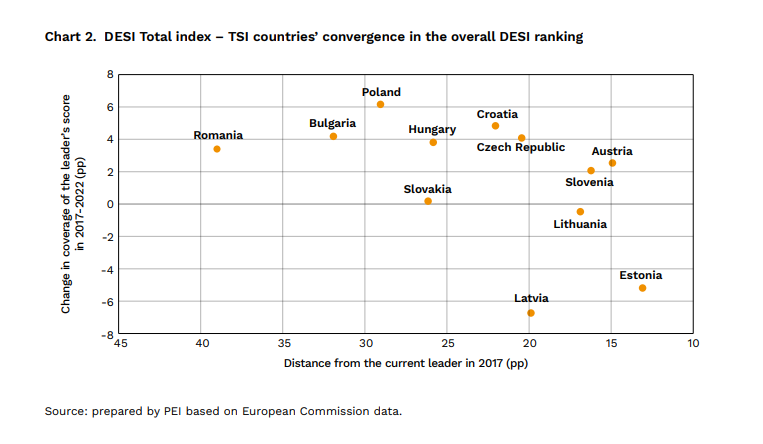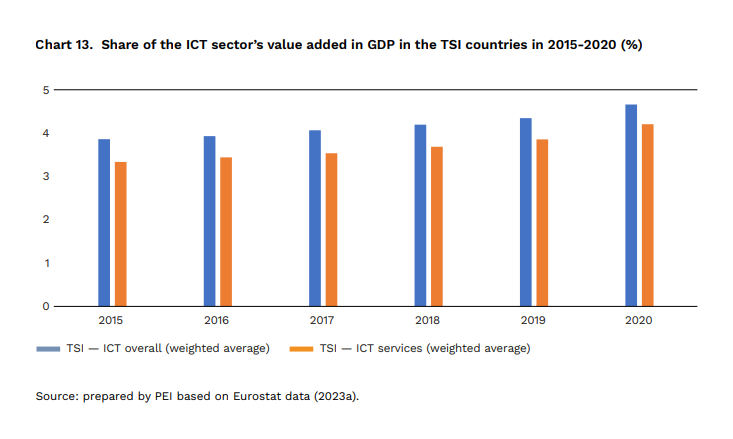The value added of the ICT sector in the Three Seas Initiative countries amounted to USD 73 billion in 2020
Published: 08/09/2023
The ICT sector in the Three Seas Initiative (TSI) countries is developing rapidly. The total value of exports of ICT goods and services from the TSI countries was USD 154 billion in 2021. The ICT industry generated USD 73 billion of value in the TSI countries and 4.7% of the region’s GDP. This has been accompanied by improvement in the level of digitalisation in the TSI countries. According to the DESI, the TSI countries are catching up with Finland, which opens the ranking, in three out of four categories. In a new report entitled “The ICT sector in the Three Seas Initiative countries as a regional driver of growth”, the Polish Economic Institute and the CEE Digital Coalition, a coalition of the digital industry in the Central and Eastern European countries, examine the TSI economies’ digital development and the ICT sector’s role and significance in the region.
The TSI countries are catching up the EU leader in terms of digitisation
Although the TSI countries — apart from Estonia — do not occupy leading positions in the Digital Economy and Society Index (DESI), which measures the level of digital development in EU countries, the distance between them and the leader has been narrowing. This convergence is taking place the most rapidly in the field of digital government services. Five TSI countries (Slovenia, Austria, Lithuania, Croatia and Estonia) score above the EU average in the digital technology integration category, which consists of indicators on companies’ use of digital technologies Slovenia ranks second in the use of ICT for environmental sustainability and first in the TSI in three subcategories.
“Although the TSI countries are often at the bottom of the DESI ranking in individual categories, it is worth looking at the changes in their scores over time, especially since countries’ position in the ranking is largely historically and structurally determined. We must also remember that the administration only has an indirect influence on the areas in which countries are significantly behind the leader. One example is the use of technology at companies. However, where the convergence is most pronounced, such as the digital public administration, we see that the administration in the TSI countries is implementing digital solutions effectively, thereby improving the quality of service for citizens,” says Jakub Witczak, an analyst on the PEI’s digital economy team.

The ICT sector’s significance in the TSI countries’ economy is growing
The TSI countries’ ICT sector is growing rapidly, as shown by the sustained increase in the share of value added in GDP, the jobs created, and the growth in trade turnover. In 2015-2020, the value added generated by the ICT sector increased by 10% on average, to 4.7% of GDP. The growing importance of ICT for the region can also be seen in the rapidly growing number of employees. In 2020, almost 1.4 million people worked in ICT services — almost a quarter of the employees in this sector across the EU. The TSI countries also have an established position in global trade, accounting for approximately 4% of trade in goods and 5.5% of trade in ICT services. The main exports of ICT goods are computers and peripheral equipment (33%), as well as telecommunications (31%) and consumer electronics (24%), while foreign sales of ICT services are dominated by computer services (81%). Germany and the United States are the region’s main trading partners, both in terms of sales of services and ICT equipment.
“The ICT sector is becoming more significant in the region. There is a constantly growing awareness that the Three Seas Initiative’s digital pillar is driving economic growth in Central and Eastern Europe. To make full use of its huge economic potential, we need close cooperation in the region and the development of ambitious, international digital projects with the TSI countries’ participation. Within the framework of the CEE Digital Coalition, we are working to deepen this cooperation,” says Michał Kanownik, president of the Digital Poland Association and initiator of the CEE Digital Coalition, a coalition of the digital industry in Central and Eastern Europe.
“The increase in trade turnover in the ICT sector, both in gross terms and in terms of value added, means that the Three Seas Initiative countries’ economies have effectively been included in the mechanisms of the international division labour and functioning of global value chains. This is the result of the inflow of foreign direct investment. The Three Seas countries’ economies face the challenge of increasing the share of domestic value added in exports, moving up global value chains, and improving mutual cooperation to equip ICT goods with advanced technology and unique qualities, and thereby boost their competitiveness,” says Bartosz Michalski, a senior advisor on the global economy team.

The TSI countries must promote their brand and invest in infrastructure
The events of the past few years, such as the pandemic and Russia’s invasion of Ukraine, have tested national economies’ resilience. In this context, the ICT sector has proven to be the Three Seas region’s strong point. Employment has continued to grow, especially in IT services, and new “unicorns” — IT companies valued at over USD 1 billion — have emerged in the region in recent years. However, the lack of a developed brand and limited regional cooperation remain a problem for the TSI countries. The ideas in the report point to the potential for cooperation and regional development, but the scale of the region’s needs and the pace at which projects are being implemented do not guarantee a breakthrough in the coming years.
“Significant investments in infrastructure are needed. This should be followed by programmes improving digital skills and educating specialists in IT and modern technologies. The region will attract further investments in production (as a result of the relocation and shortening of production chains), but the lack of qualified staff and infrastructure deficiencies increasingly emphasised by companies could be a barrier. If they overcome these barriers, the Three Seas Initiative countries could further strengthen their position in services,” says Ignacy Święcicki, head of the PEI’s digital economy team.
***
The Polish Economic Institute is a public economic think-tank dating back to 1928. Its research primarily spans macroeconomics, energy and climate, the world economy, economic foresight, the digital economy and behavioural economics. The Institute provides reports, analyses and recommendations for key areas of the economy and social life in Poland, taking into account the international situation.
Media contact:
Ewa Balicka-Sawiak
Press spokesperson
T: +48 727 427 918
E: ewa.balicka@pie.net.pl
***
The CEE Digital Coalition is a coalition of the digital industry and new technologies in Central and Eastern Europe. It works to accelerate the digital transition of the region’s economy and information society. It also strives to promote close business cooperation between the Three Seas Initiative countries in the digital sphere. The coalition was initiated by the Digital Poland Association in 2020. It is currently made up of 18 digital industry organisations from 11 countries in Central and Eastern Europe.
Łukasz Antkiewicz
T: +48 501 772 870
E: lukasz.antkiewicz@cyfrowapolska.org
Category: Digital Economy / Report / Reports 2023





